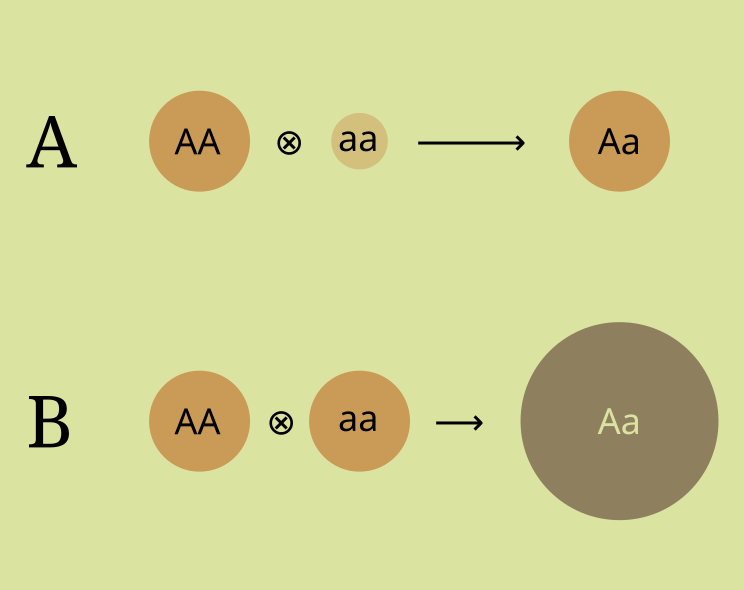OCR Specification focus:
‘Explain selective breeding in plants and animals, the need to maintain genetic resources, and evaluate ethical considerations in extreme cases.’
Artificial selection, also called selective breeding, is the intentional breeding of organisms with desirable traits to produce offspring expressing those traits. It underpins agriculture, animal husbandry, and biotechnology worldwide.
Principles of Artificial Selection
Selective Breeding Overview
Artificial selection mirrors natural selection but with human intervention directing which individuals reproduce. Desired characteristics are chosen based on economic, aesthetic, or functional importance, such as yield, disease resistance, or temperament.
Humans choose parent organisms displaying phenotypic traits of interest.
These individuals are bred together.
Offspring showing the preferred traits are selected for further breeding.
Over successive generations, the trait becomes genetically fixed within the population.
This process narrows the gene pool, as only a limited number of alleles are passed on, leading to potential genetic vulnerabilities.
Types of Artificial Selection
Directional Selection in Breeding
Humans apply directional selection by consistently breeding individuals with extreme phenotypes for a particular trait. For example, cows producing the highest milk yields or wheat with the largest grain size are bred together, pushing the population mean in one direction.
Inbreeding
Inbreeding occurs when genetically related individuals are bred. This increases homozygosity and helps preserve desirable traits but can expose deleterious recessive alleles, leading to inbreeding depression — reduced fertility, health, and adaptability.
Outbreeding
Outbreeding (or crossbreeding) involves mating unrelated individuals or different breeds/species to introduce genetic variation. This can produce hybrid vigour (heterosis), where offspring outperform parents in fitness, growth rate, or productivity.

Labeled schematic comparing two hypotheses for heterosis: (A) masking of deleterious recessive alleles and (B) overdominance in heterozygotes. It aligns with your explanation that crossbreeding can yield fitter offspring. (The figure names the hypotheses explicitly; this is extra detail but fully syllabus-appropriate.) Source.
Artificial Selection in Plants
Principles in Crop Breeding
Selective breeding in plants enhances yield, disease resistance, and resilience to environmental stresses.
Common methods include:
Self-pollination control to maintain desirable homozygous traits.
Cross-pollination to introduce beneficial variation.
Backcrossing to retain elite traits while adding a single new gene.
Examples:
Breeding wheat varieties for drought tolerance.
Developing disease-resistant potatoes using wild relative genes.
Artificial selection can also increase nutritional value, such as high-protein maize or vitamin-enriched rice.
Limitations in Plant Breeding
Reduced genetic diversity makes crops more vulnerable to pests and disease.
Overemphasis on yield can compromise other qualities, such as flavour or nutrient content.
Selective breeding may take many generations to stabilise new traits.
Artificial Selection in Animals
Principles in Livestock Improvement
Selective breeding in animals aims to enhance traits like milk yield, growth rate, meat quality, or behaviour.
Key stages:
Identify desirable characteristics.
Select breeding stock based on phenotypic assessment or genetic testing.
Control mating to fix traits.
Record and monitor outcomes through pedigree systems.
Examples include:
Dairy cattle bred for higher milk output.
Sheep selected for finer wool.
Dogs bred for behaviour, size, or appearance.
Consequences of Animal Breeding
Artificial selection in animals often reduces genetic variation, increasing susceptibility to inherited diseases. For instance, pedigree dogs may develop congenital disorders such as hip dysplasia or heart defects due to selective inbreeding.
Additionally, selecting for a single characteristic (e.g., rapid growth in broiler chickens) can create welfare problems, such as skeletal deformities or metabolic stress.
Maintenance of Genetic Resources
Importance of Genetic Diversity
Genetic resources refer to the complete variety of genes within a species and its relatives. Conserving these ensures the ability to adapt to environmental change, disease, or food security threats.
Loss of genetic diversity through artificial selection can reduce a population’s evolutionary potential, making it less resilient.
Conservation Strategies
To counteract genetic erosion, scientists use:
Seed banks – long-term storage of seeds under controlled conditions (e.g., the Svalbard Global Seed Vault).
Gene banks – preservation of animal gametes, embryos, or tissue samples.
Cryopreservation – freezing biological material for future use.
Wild population conservation – protecting wild relatives of domesticated species.
These measures maintain allelic variation essential for future breeding and genetic engineering projects.

Entrance to the Svalbard Global Seed Vault, a secure long-term repository preserving crop genetic diversity. Seed samples from worldwide genebanks are stored under controlled conditions to safeguard breeding material against disease, conflict, and climate threats. This real-world facility exemplifies your notes’ seed bank strategy. Source.
Ethical Considerations in Artificial Selection
Animal Welfare Issues
Artificial selection raises ethical questions concerning animal suffering and human responsibility. Selecting for exaggerated traits (e.g., flat-faced dogs) may lead to chronic health problems. Ethical breeding should prioritise welfare, not just aesthetics or productivity.
Human Intervention and Natural Integrity
Some critics argue that artificial selection disrupts natural evolutionary processes and challenges the integrity of species. Others contend that humans have a moral obligation to improve food production efficiently and sustainably.
Food Security and Equity
Selective breeding has improved global food supplies but often concentrates genetic resources and benefits within a few commercial entities. Ethical concerns include:
Ownership of genetic resources by corporations.
Loss of indigenous breeds and traditional knowledge.
Access inequality between developed and developing nations.
Sustainable and Ethical Breeding Practices
To address ethical issues, modern breeding programmes incorporate ethical frameworks that balance productivity, welfare, and conservation.
Good practices include:
Ensuring genetic monitoring to avoid excessive inbreeding.
Using crossbreeding to restore genetic health.
Complying with welfare standards and bioethical guidelines.
Supporting conservation of traditional breeds and wild relatives.
Summary of Ethical Debate Themes
Balancing human benefit versus animal welfare.
Ensuring long-term sustainability through genetic diversity.
Preventing genetic exploitation for commercial gain.
Maintaining ecological responsibility in manipulating life forms.
FAQ
Selective breeding relies on choosing parent organisms with desirable traits and allowing natural reproduction, meaning the offspring inherit genes already present within the species.
Genetic engineering, in contrast, involves directly altering DNA — inserting, deleting, or modifying genes, often using genes from other species.
Selective breeding is slower and limited by available variation, while genetic engineering produces faster, targeted changes but raises additional ethical and regulatory concerns.
In small populations, related individuals are more likely to mate, increasing homozygosity and the chance of recessive harmful alleles being expressed.
This can lead to:
Reduced fertility and litter size.
Increased susceptibility to disease.
Developmental abnormalities or reduced survival.
Over time, inbreeding depression can threaten population viability and limit the success of selective breeding programmes.
Wild relatives contain alleles that may have been lost in domesticated species through selective breeding.
These alleles often confer resilience to stresses such as drought, salinity, or pests.
Plant breeders use backcrossing to reintroduce such alleles into cultivated strains while retaining desirable commercial traits.
Wild relatives therefore act as a crucial gene reservoir supporting crop improvement and food security.
Modern programmes apply principles of animal welfare, sustainability, and biodiversity protection.
They typically involve:
Avoiding breeding for traits causing pain or distress.
Maintaining a minimum effective population size to preserve genetic diversity.
Ensuring transparency and compliance with welfare legislation (e.g., UK Animal Welfare Act 2006).
Balancing productivity with ethical responsibility to animals and ecosystems.
These frameworks aim to align agricultural progress with moral accountability.
Seed banks store seeds at low temperatures and humidity to slow metabolic activity and prevent decay.
They regularly test germination rates to monitor seed health and replace deteriorating samples through regeneration in controlled conditions.
Backups of the same seeds are kept in multiple locations — for example, duplicates from global collections are stored in the Svalbard Global Seed Vault — ensuring genetic material remains available even after local losses.
Practice Questions
Question 1 (2 marks)
State two potential disadvantages of artificial selection in animal populations.
Mark scheme:
1 mark for each correct disadvantage (maximum 2 marks).
Any two from:
Reduced genetic variation within the population.
Increased incidence of inherited disorders due to inbreeding.
Reduced ability to adapt to environmental change or disease.
Possible animal welfare concerns from breeding for extreme traits.
Question 2 (5 marks)
Discuss how artificial selection in plants and animals can lead to a loss of genetic diversity, and explain why maintaining genetic resources is important.
Mark scheme:
1 mark: Explanation that artificial selection involves breeding individuals with specific desirable traits, reducing the range of alleles in the gene pool.
1 mark: Description that repeated selection over generations can cause certain alleles to become fixed and others lost.
1 mark: Recognition that reduced genetic diversity increases vulnerability to disease, environmental change, or reduced fertility.
1 mark: Explanation of what is meant by genetic resources (the total variety of genes within and between species).
1 mark: Description of why maintaining genetic resources is important, e.g. for future breeding, adaptation, and food security.

